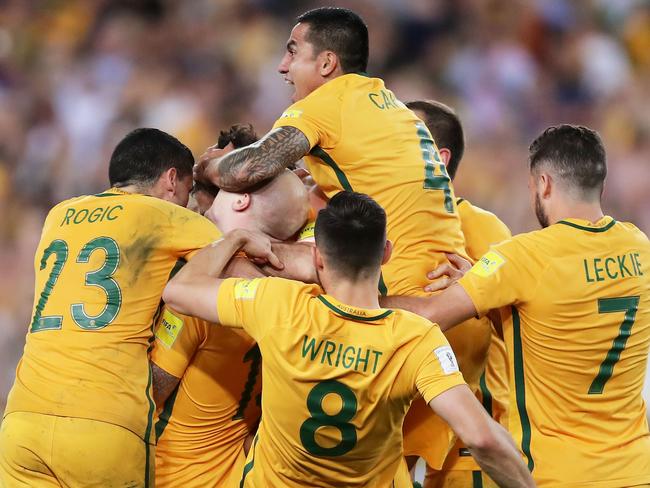World Cup 2018: The burning questions
AUSTRALIA has been given no chance of doing any damage in Russia after the pots for the World Cup were confirmed.

Football
Don't miss out on the headlines from Football. Followed categories will be added to My News.
THE field is finalised. Peru is the 32nd and final nation to secure a place at next year’s World Cup in Russia after a 2-0 win against New Zealand.
The Kiwis were unable to match the Socceroos heroics from a day earlier and will watch from home along with the likes of Italy, the Netherlands, Ghana, Chile and the US.
For Peru, Australia — and the 30 other countries headed to the tournament starting in June — the next step is the World Cup draw on December 1.
WHO MADE IT?
The 32 countries that will compete at next year’s World Cup finals in Russia are:
Europe: Russia (qualified as hosts, world ranking: 65), France (7), Portugal (3), Germany (1), Serbia (38), Poland (6), England (12), Spain (8), Belgium (5), Iceland (21), Switzerland (11), Croatia (18), Sweden (25), Denmark (19)
South America: Brazil (2), Uruguay (17), Argentina (4), Colombia (13), Peru (10)
Africa: Nigeria (41), Egypt (30), Morocco (48), Tunisia (28), Senegal (32)
Central America: Mexico (16), Costa Rica (22), Panama (49)
Asia: Iran (34), Japan (44), South Korea (62), Saudi Arabia (63), Australia (43)
This means four of the world’s five largest countries — population-wise — will be absent at next year’s event. Brazil is safely through but China, India, the USA and Indonesia failed to qualify.
The combined population of nations competing in the World Cup is approximately 1.6 billion, leaving the other 5.91 billion people on earth without a team to cheer for.
HOW DOES THE DRAW WORK?

Teams have been split into four pots based on their FIFA world ranking. Pot One contains the seven highest-ranked sides plus tournament hosts Russia.
Pot Two features the next best teams, and so on and so forth for Pots Three and Four. Australia finds itself in pot four.
Pot One: Germany, Brazil, Portugal, Argentina, Belgium, Poland, France, Russia
Pot Two: Spain, Peru, Switzerland, England, Colombia, Mexico, Uruguay, Croatia
Pot Three: Denmark, Iceland, Costa Rica, Sweden, Tunisia, Egypt, Senegal, Iran
Pot Four: Serbia, Nigeria, Australia, Japan, Morocco, Panama, South Korea, Saudi Arabia
These countries will then be divided into eight groups of four from A to H with each side playing three times before the top two advance to the second round. Russia will be dropped into Group A as hosts.
FIFA limits each of the four-team groups to a maximum of two European teams. No two teams from any other continental confederation can be drawn together. Potentially tough draws could group Brazil, Spain, Egypt and Serbia, and Germany with England, Costa Rica and Nigeria.
WHAT ARE OUR CHANCES?

If you listen to the rest of the world, slim to none.
The Guardian’s Ed Aarons has ranked Australia as the worst team to book a spot in Russia, saying “the exhilaration at reaching a fourth successive World Cup following the playoff victory over Honduras may not last long if Australia revert to type in Russia” and calling out a lack of matchwinning ability outside of Tim Cahill as the side’s biggest worry.
“It is clear manager Ange Postecoglou has some major problems. In particular, finding an alternative match winner to veteran Tim Cahill will be a major priority between now and the opening match in Russia,” Aarons wrote.
Bleacher Report also had the men in green and gold running dead last in order of who to fear most.
“No one will be expecting much of the Socceroos come June,” Sam Tighe wrote. “They’re gritty and workmanlike, but the final ball in the final third is likely to let them down too often.”
But there’s a sliver of hope if you listen to Sports Illustrated’s Jonathan Wilson. He’s placed Saudi Arabia and Panama below the Socceroos in his power rankings, but says form away from home is a huge concern.
“The big concern must be that the Socceroos haven’t won any of their last nine games outside of Australia,” he wrote.
For perspective, here’s who those publications ranked among their top five contenders.
Guardian: Germany, Brazil, Spain, France Belgium
Bleacher Report: Germany, Brazil Spain, France, Argentina
Sports Illustrated: Brazil, Spain, Germany, France, Belgium
The bookmakers aren’t given the Socceroos much hope of doing any damage in Russia either. Immediately following Wednesday night’s win he TAB had Ange Postecoglou’s side a $201 outsider to win the tournament — and a short-priced $1.25 to be eliminated in the group stage.
Australia is $3.40 to win a match and $3 to score more than two goals.
WHAT’S NEXT FOR THE SOCCEROOS?

Firstly, Australia needs to find out whether Ange Postecoglou plans to be coaching the team in Russia.
Postecoglou says he’ll end the guessing game over his World Cup availability by the end of the month after showdown talks with FFA chairman Steven Lowy and chief executive David Gallop.
The national team coach guided Australia to the 2018 World Cup finals with a 3-1 win over Honduras on Wednesday night.
On Thursday, he revealed a two-week timeline to confirm a decision on whether he leads the team to Russia.
“I’m determined to enjoy this and determined for everyone to enjoy it,” Postecoglou said at a public event in Sydney’s Martin Place on Thursday. “I understand the conjecture ... it’s not about me trying to keep people in suspense.
“I’ll have those discussions with David and Steven in the next two weeks and it will all be resolved.”
Australia will also plan several warm-up matches to finetune its team.
Originally published as World Cup 2018: The burning questions
